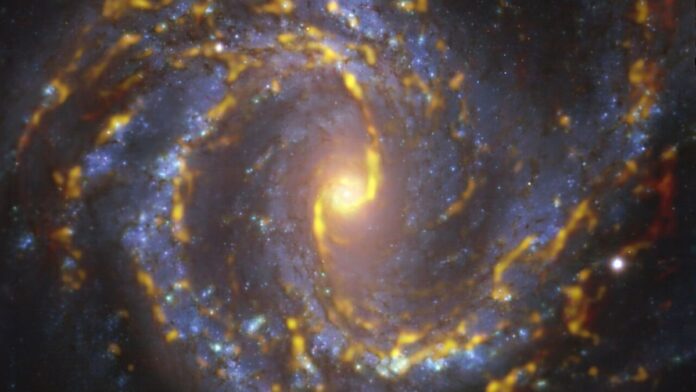A newly released stunning image of a distant spiral galaxy shows its features in resplendent shining gold and bright blue.
The image of the galaxy NGC 4303 located 55 million light-years from Earth was created by two cutting-edge telescopes in radio waves and visible light as part of the Physics at High Angular resolution in Nearby GalaxieS (PHANGS (opens in new tab)) project.
Also known as Messier 61 (M61) a name that comes from its 18th-century co-discoverer Charles Messier who observed it on the same night as Italian astronomer Barnaba Oriani, NGC 4303 is one of the larger galaxies of the Virgo Cluster.
Related: What Is a Spiral Galaxy?
NGC 4303 is an example of a “starburst galaxy,” a type of galaxy that experiences an exceptionally high rate of star formation. The fuel for this star-birthing process is clouds of cool molecular gas, and these stellar building blocks are visible in the image as the golden glow which was captured by the Atacama Large Millimeter/submillimeter Array (ALMA) located in the Chilean Andes.
The blue regions of NGC 4303, seen in the background of the image, reveal the galaxy’s already-formed stars. These aspects of this region were captured by the Multi-Unit Spectroscopic Explorer (MUSE (opens in new tab)), part of the Very Large Telescope (VLT), which also happens to be located in Chile.
Uniting the images allows astronomers to compare the distribution of the gas and stars in the galaxy. This should allow scientists to investigate what triggers star formation in galaxies, what enhances and, eventually, what halts the birth of new stars.
Not visible in the joint ALMA/MUSE image is the strong X-ray source located deep in the heart of NGC 4303. Astronomers believe this is the result of a so-called “Active Galactic Nucleus” (AGN) powered by a feeding supermassive black hole with a mass estimated to be as great as 5 million times that of the sun.
The PHANGS project makes high-resolution observations of nearby galaxies with a range of telescopes including the James Webb Space Telescope (JWST). The aim of PHANGS is to reveal how physics on the scale of gas and star formation interplays with galactic structure and galaxy evolution.
Follow us on Twitter @Spacedotcom (opens in new tab) or on Facebook (opens in new tab).

